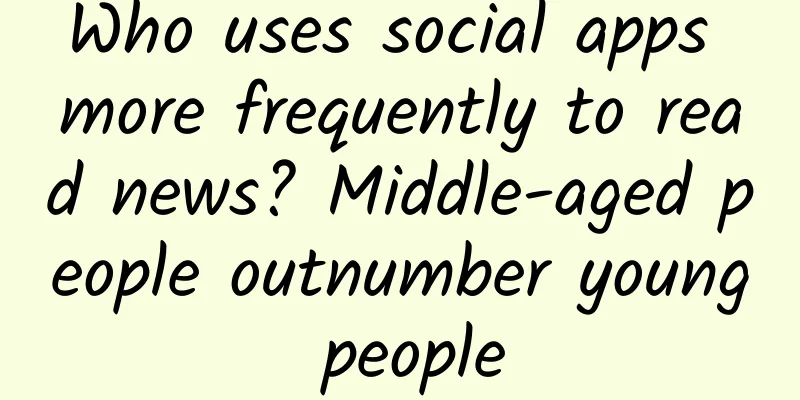Who uses social apps more frequently to read news? Middle-aged people outnumber young people

|
How many times does a WeChat user check Moments on average every day? The answer is 30 to 40 times. This data comes from a public speech by WeChat "Boss" Zhang Xiaolong in early 2016. Users frequently visit their Moments to check “who liked my post”, “who went where to eat, drink and have fun”, and of course “who shared what news”. From Weibo to WeChat, social applications have taken on an increasingly important function in news dissemination, not only cultivating users' new tastes in reading news, but also giving rise to a group of content creators and organizations with the label of "self-media". Looking back at the year 2015, how did social networks, the bridge between users and the media, change the relationship between the latter two? Penguin Intelligence uses data from 11,000 respondents to tell you the answer. 1. 70% of users use social apps to read news more frequently than before The frequency of using social apps to read news has increased, becoming a common phenomenon. 70.2% of users said that they used social apps to read news more in the past year than in previous years. It is worth noting that the increase in usage frequency is more obvious among middle-aged users. For example, among users aged 30 to 39, the rate is 73.6%, and among users aged 40 to 49, the rate is 74.8%, both of which are higher than the average. In terms of region, this phenomenon is more prominent among users in county towns. 2. Photo news touched the hearts of young users Using richer forms of expression, such as using pictures and videos to enhance the readability of news, has become an essential tool for media content innovation. Looking back at the articles shared in WeChat Moments over the past year, it is not difficult to see more media using pictures, animated pictures, and even emoticons to tell stories. According to user feedback, 30.4% of people think they like to read news with pictures more and more, especially young people, with 33.9% of users aged 10 to 19 and 34.6% of users aged 20 to 29. Among those who increasingly use social apps to read news, 33.2% also say they prefer to read news with pictures. 3. Self-media has a high reading frequency, but the readership is adults WeChat's "self-media", a group of individual content creators that was born in 2012, emerged in 2013, and exploded in 2015, has benefited from the construction of the WeChat public platform and WeChat's social communication circle, and its identity recognition has expanded to the general public. The survey shows that 64.7% of users said they knew about self-media. Among those who knew about self-media, 52.4% said they read self-media articles at least once or more every day. People who frequently read self-media articles are not young people such as students, but adults who have already entered the workplace. For example, among users aged 30 to 39, 55% read them every day, while among users under 20, this proportion is only 21.2%. Summary: The readership of self-media can only be adults? Getting news through social apps is not exclusive to young people. In the past year, the proportion of middle-aged people who frequently use social apps to get news has exceeded that of young people. This also means that the media can now reach more age groups through social channels. Self-media content exploded in 2015, and its readership tends to be adults who have already entered the workplace. The content is also mostly focused on providing industry observations, interpretations of hot social events, and life consumption guides. Seizing a group of adult users who gradually rely on social applications as a channel for reading news is the growth dividend of self-media. If current self-media focuses on serving adults entering the workplace, then who is currently serving student users who are under 20 years old but have already entered social applications? Looking back at the above data, 65% of users under the age of 20 said that they increasingly read news through social applications, but only 21.2% of users under the age of 20 frequently read self-media. In the 2015 WeChat Life White Paper released by WeChat, the official highlighted the following point: "60% of WeChat users are young people (15 to 29 years old)." In the current situation, WeChat has the attribute of workplace social networking. As WeChat also pointed out in the report, the number of friends of users increases by 20% after graduating from college and working. But as more young user groups join, they also need to find interesting, interesting and shareable content here. What are the growth dividends for content producers in 2016? Maybe it’s time to think about what those under 20 like. |
<<: Alibaba's 2016 foreign trade strategy in one chart
>>: Mobvoi launches the "Mobvoi App Store", Android Wear is gaining popularity
Recommend
Douyin Promotion: How to seize the Douyin bonus period?
Tik Tok is the most popular short video APP at th...
What are the advantages and disadvantages of website subdomains for optimizing rankings?
For webmasters and SEO personnel who are new to w...
What is the use of NFC on mobile phones? These 6 functions are very practical. If you don't know how to use your mobile phone, you will buy it in vain.
When mobile payment began to become the main tren...
Linux tablet JingPad A1 starts crowdfunding, can it be comparable to iPad?
Recently, the company behind "JingOS" (...
Android Webview Java and Javascript safe interaction
Recently, I need to detect the source code of a w...
Is the ultimate goal of the development of wearable devices to replace human organs?
[[161064]] Although wearable devices have experie...
Android SDK Development - Release and Use Pitfalls
Preface During the Android development process, s...
Apple Developer Affairs Contact Email List
[email protected] - The status of the app and i...
Technical interview strategies worth reading
Neil Roseman is tired of Silicon Valley companies...
Cocos Chengdu Developer Salon unveils the mystery of cocos 3D functions and H5
If there is a salon that stands at the height of ...
How to correctly analyze the trend of DAU daily active users from 5 dimensions?
The previous article analyzed the DAU decompositi...
Zhang Qi's "Traffic Digging and Exploring Omni-channel Growth" has 3 major sections to decipher traffic strategies and easily get the code for network-wide growth
Training course video lecture content introductio...
Start from scratch to analyze user operation cases
What I want to share with you today is the user o...
What superpowers do growth hackers need?
I've recently been reading Fan Bing's &qu...
You were busy celebrating the National Day, but these big things happened in the technology circle
[[151069]] Large companies October 3: Google offi...









